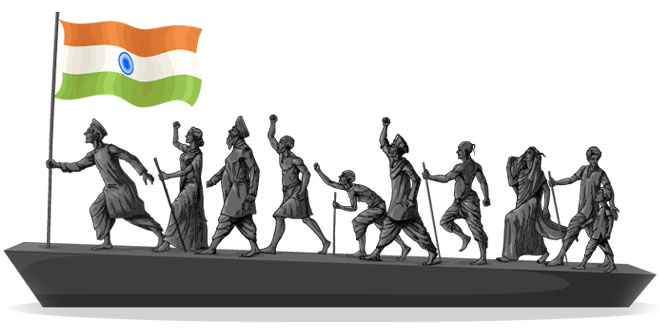Question: “Plantation workers too had their own understanding of Gandhiji’s notion of Swaraj.” Explain.
Answer:
- For plantation workers in Assam, freedom meant the right to move freely in and out of the confined space in which they were enclosed, and it meant retaining a link with the village from which they had come.
- The government had passed the Inland Emigration Act of 1859 under which plantation workers were not permitted to leave the tea estates without permission, and in fact, they were rarely given such permission.
- When the plantation workers heard of the Non-Cooperation Movement, thousands of them defied the authorities, left the plantations and headed towards their homes.
- The plantation workers believed that the Gandhi Raj was coming, and everyone would be given land in their own villages.
Question: Why did the tribal people join the Cooperation Movement?
Answer: Most of the tribal people were dependent on forests for their livelihood but under the new Forest Policy, the government had put several restrictions on the people:Closing large forest area for the tribal people. Forcing the local people to contribute begar. Preventing people from entering the forests to graze their cattle, or to collect fuelwood and fruits. All these steps enraged the hill people. Not only were their livelihoods affected, but they felt that their traditional rights were also being denied. So the people revolted.
Question: Explain the circumstances under which Non-cooperation Movement was withdrawn. Or Why was the Non-Cooperation Movement withdrawn by Gandhiji in February 1922. Explain the reasons. Or Explain the conditions of the plantation workers during the colonial rule in India.
Answer: In February 1922, Gandhiji decided to withdraw the Non-Cooperation Movement due to the following reasons:
- The movement was turning violent. At Chauri-Chaura in Gorakhpur, a peaceful demonstration in a bazaar turned into a violent clash in which more than 20 policemen were killed.
- Gandhiji felt that the Satyagrahis needed to be properly trained before they would be ready for mass struggle.
- Within the Congress, some leaders were tired of mass struggles and wanted to participate in elections to the provincial councils, which were set up under the Government of India Act, 1919.
- Industrialists, workers, peasants etc. interpreted the term ‘Swaraj’ in their own way. At many places like that of Andhra Pradesh, leaders like Alluri Sitaram Raju asserted that India could be liberated only by the use of force. But there values were not approved by the Congress.
Question: When was the Gandhi-Irwin Pact signed? Mention the provisions of the pact.
Answer: Gandhi-Irwin Pact was signed on 5th March, 1931. Provisions of the pact
- Gandhiji consented to participate in the Second Round Table Conference.
- The government agreed to release the political prisoners.
Question: Why was the Swaraj Party formed? By whom was the party formed?
Answer: There were some Congress leaders who argued or advocated the idea of fighting the British from within the legislative councils. They wanted to pressurize the government for various reforms through councils. They also wanted to demonstrate that these councils were not truly democratic. Keeping in mind these objectives, C.R. Das and Motilal Nehru formed the Swaraj Party in 1922.
Question: Why was the Simon Commission constituted? Why was the commission rejected by the Indians?
Answer: The Indian members of the Central Legislative Assembly exposed the drawbacks in the Government of India Act of 1919 A.D. As a result of it, the Simon Commission was appointed in 1927 A.D. to suggest any further constitutional reforms. This commission consisted of seven members and its Chairman was Sir John Simon. However Indians boycotted the commission, because: (1) There was no Indian member in this commission. (2) The terms of the commission’s appointment did not give any indication of Swaraj while the demand of the Indians was only Swaraj.
Question: Under what circumstances, the Puma Swaraj was demanded by the Congress? Or Mention the main contents of resolution passed in the Lahore Session of Indian National Congress in December 1929 held under the leadership of Jawaharlal Nehru. Or Explain the reason for the Lahore Session of the Congress in 1929 to be called the historical session.
Answer:
- The Simon Commission had to face demonstration all over India, and no party was in favor of the Commission. So in an effort to win the political parties the Viceroy, Lord Irwin, announced in October 1929, a vague offer of “dominion status’ for India in an unspecified future and a Round Table Conference to discuss a future constitution.
- The announcement fell short of the expectations of the Congress. At its Lahore Session, presided over by Pandit Jawaharlal Nehru in December, 1929, the Congress passed a resolution boycotting the Round Table Conference. It declared “Purna Swaraj” (Complete Independence) as its goal, and took steps to launch a programme of Civil Disobedience. The Puma Swaraj Day was celebrated all over India on 26th January, 1930.
 Class Notes NCERT Solutions for CBSE Students
Class Notes NCERT Solutions for CBSE Students





